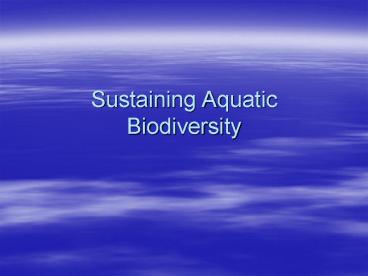Sustaining Aquatic Biodiversity - PowerPoint PPT Presentation
1 / 22
Title:
Sustaining Aquatic Biodiversity
Description:
Sustaining Aquatic Biodiversity Questions for Today What are the major threats to aquatic biodiversity (HIPPCO)? How can we protect and sustain marine biodiversity? – PowerPoint PPT presentation
Number of Views:244
Avg rating:3.0/5.0
Title: Sustaining Aquatic Biodiversity
1
Sustaining Aquatic Biodiversity
2
Questions for Today
- What are the major threats to aquatic
biodiversity (HIPPCO)? - How can we protect and sustain marine
biodiversity? - How should we manage and sustain marine
fisheries? - How can we protect and sustain wetlands?
- How can we protect and sustain freshwater lakes,
rivers, and fisheries?
3
Remember
- The greatest biodiversity occurs in coral reefs,
estuaries, and deep ocean floor. - Biodiversity is higher near coasts because of the
greater variety of producers and habitats in
coastal areas. - Biodiversity is greater in the bottom region of
the ocean because of habitats and food sources.
4
HIPPCO!!!!Greatest Threats to Biodiversity ?
- H stands for Habitat Loss and Degradation.
- 90 of fish living in the ocean spawn in coral
reefs, mangrove forests, coastal wetlands, or
rivers. - The above areas are under intense pressure from
human activities. (dredging, trawling, dams,
excessive water withdrawal)
5
HIPPCO
- I stands for Invasive Species!!
- These bioinvaders can displace or cause
extinction of native species and disrupt
ecosystem services. - 84 of worlds coastal waters are being
colonized by invaders! (Water hyacinth, Asian
swamp eel, zebra mussel, purple loosestrife are
some examplesp. 252 for details)
6
Water Hyacinths
7
Zebra Mussels in the Great Lakes
8
HIPPCO
- P
- The first P in HIPPCO is coastal Population
Growth. - More people moving to coastal areas destroy
habitat and increases pollution.
9
HIPPCO
- P
- The second P is Pollution!! ?
- 80 of all pollution comes from land-based
activities. - Humans have doubled the flow of nitrogen, mostly
from nitrate fertilizers since 1860. Similar
inputs of phosphorous have occurred. (They cause
eutrophication, which can lead to algal blooms,
fish die-offs, and degradation of ecosystems.)
10
- Similar pressures are occurring in freshwater
systems. Massive inputs of sediment and wastes
from land due to construction of homes and
recreation areas. - Things that are polluting waters are toxic
pollutants from industry and plastics dumped in
water.
11
HIPPCO
- C
- The C in HIPPCO is Climate Change!
- Sea levels rise, destroying coral reefs, swamping
islands, drowning highly productive coastal
wetlands, and inundating coastal cities like New
Orleans. - Mangrove forests that protect islands will be
destroyed or damaged.
12
HIPPCO
- The BIG O in HIPPCO is OVERFISHING!!
- Industrialized fishing has depleted marine life
at an alarming rate. - The fishprint is defined as the area of ocean
needed to sustain the consumption of an average
person, a nation, or the world. - All the worlds nations together are overfishing
the global oceans by an unsustainable 157!!!! ? - In most cases, this leads to commercial
extinction.
13
- Fish species are also threatened with biological
extinction, mostly from overfishing, water
pollution, wetlands destruction, and excessive
removal of water from rivers and lakes. - Marine and freshwater species are threatened with
extinction by anthropogenic activities more than
any other group of species!!! (OUR fault!)
14
(EVIL) Industrial Fish Harvesting Methods
- These methods are vacuuming the seas!!
- Trawlers
- Purse-seine
- Longlining
- Drift nets
- Sonar and Spotter airplanes help the fishers find
their prey!
15
Fish farming in cage
Trawler fishing
Spotter airplane
Purse-seine fishing
Sonar
Drift-net fishing
Long line fishing
Float
Buoy
lines with hooks
Deep sea aquaculture cage
Fish caught by gills
Fig. 11-7, p. 256
16
Trawling Before and After
17
What can the government do?
- There are different ways the government can help
the environment - Pass Laws
- Regulate people and fine those that break the law
- Levy Taxes or subsidize for positive responses.
- Educate the people
- Community Outreach Organizations
- Public Service Announcements
- Create Reserves and Mitigate new land.
18
How Can We Protect and Sustain Marine
Biodiversity??
- CITES 1975 Convention on International Trade in
Endangered Species - The U.S. Marine Mammal Protection Act of 1972
- The U.S. Endangered Species Act of 1973
- U.S. Whale Conservation and Protection Act of
1976 - 1995 International Convention on Biological
Diversity
19
Wetlands are cool, K?
- Wetlands are important because
- they are natural filters
- they are breeding grounds for coastal wildlife
- they are very biologically diverse
20
How Should We Protect and Sustain Wetlands?
- Wetlands have been drained, filled in, or covered
over to create rice fields, crop land, cities,
and roads. - Wetlands have been destroyed by processes of
extracting minerals and oil. - AND to reduce breeding grounds of disease causing
insects.
21
- How to Preserve and Restore Wetlands??
- Mitigation banking allows destruction as long as
an equal area is created or restored. - Not the best idea though!
- Buy wetlands and restore them with help of EPA or
US Corps of Engineers
22
FRESHWATER ISSUES! ?
- Aside from HIPPCO, one way that humans have
destroyed freshwater ecosystems are through the
creation of Dams. - Dams create different economic and environmental
benefits and problems. - We will further discuss dams during our renewable
energy unit.

